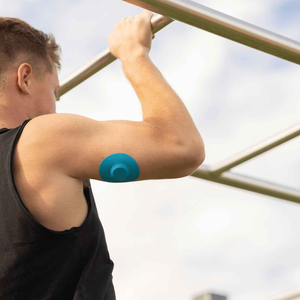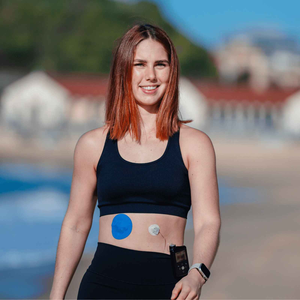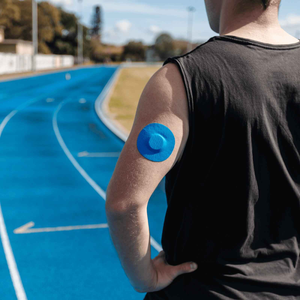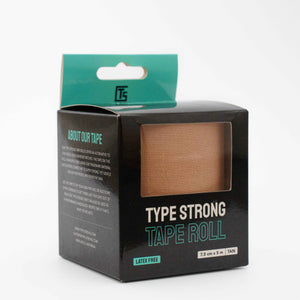Scroll through TikTok or Instagram for a few minutes and you’ll probably see it — a small round sensor tucked under a colourful patch on someone’s arm. Sometimes it flashes during a dance video, other times it appears in a “what I eat in a day” clip. A few years ago, that same sensor might have been hidden under clothing. Now it’s part of the story.
Continuous glucose monitors (CGMs) are no longer just quiet medical tools; they’ve become symbols of openness, resilience, and daily self-care. At Type Strong, we’ve watched this shift with real admiration. Every photo or short video shared online helps to normalise something that once carried stigma.
Visibility that builds understanding
There’s a quiet power in being seen. When people share their CGM on social media, they show that living with diabetes can look active, stylish, and completely ordinary. That visibility slowly breaks down the feeling of being “different.”
According to Diabetes UK (2024), visible representation plays a major role in tackling diabetes stigma. Seeing someone confidently wear their device encourages others to do the same — especially those adjusting to their first CGM.
This confidence goes hand-in-hand with good care. You can learn more about protecting your device in warmer months in our post on why your CGM sensor needs extra protection in summer.
Honest creators, genuine influence
The most powerful diabetes content online rarely looks polished. It’s the creator laughing after a sensor alarm at the gym, or showing a blood-glucose spike after pizza. These small moments make the technology feel real and human.

Instead of fear or perfection, these influencers show honesty. They remind viewers that numbers fluctuate, days vary, and that’s okay. It’s this authenticity that keeps followers engaged — and it’s reshaping trust within the diabetes community.
You’ll also notice how creativity slips into care. Custom-coloured overpatches and seasonal prints have turned CGM covers into style choices. Our article on sensor patches as fashion looks at how something small, like a patterned patch, can make wearing a sensor feel more personal and positive.
From stigma to solidarity
A decade ago, diabetes rarely trended online. Now hashtags like #CGMCheck and #DiabetesAwareness link thousands of people who swap tips, jokes, and daily updates. The change is subtle but powerful: the same platforms that once amplified insecurity now build community.
These shared spaces are where people learn practical lessons, like proper skin prep before applying a patch or tricks for keeping sensors comfortable during workouts. When advice comes from peers rather than instructions, it feels doable.
Table – How social media is reshaping diabetes perception
|
Platform |
What people share |
How it helps |
|
TikTok |
Day-in-the-life glucose updates, patch reveals |
Normalises daily sensor use |
|
|
Style photos showing CGMs proudly |
Connects diabetes care to identity |
|
YouTube |
Tutorials, vlogs, Q&As |
Builds trust through long-form honesty |
|
Threads / X |
Advocacy threads, quick reflections |
Encourages empathy and open talk |

Sharing safely without losing authenticity
Openness is empowering, but privacy still matters. A good rule of thumb is to share what helps others without showing what identifies you. Keep sensor serial numbers, GPS locations, and detailed medical data out of frame.
If you ever notice irritation or redness, choose products made for sensitive skin. Our guide on what makes a CGM patch hypoallergenic explains how breathable, latex-free adhesives protect both comfort and safety.
Posting responsibly means you’re educating without oversharing — a balance that keeps the conversation healthy.
Turning online confidence into everyday strength
The real impact of the CGM social media trend isn’t measured by followers. It’s seen when someone stops hiding their sensor, joins a sports team, or wears short sleeves without a second thought. What starts online often becomes confidence in real life.
If you’re active on camera or outdoors, a secure fit matters. Our breathable CGM patches and adhesive wipes help sensors stay put through workouts, swimming, and long filming sessions. Feeling secure lets you focus on living — not adjusting your patch.
People also ask
How are CGM users changing how diabetes is seen online?
They’re showing real-life management instead of stereotypes, proving diabetes doesn’t define lifestyle or ability.
Why do influencers post their CGM data?
Most do it to educate and to show that glucose changes are normal. Transparency builds trust and breaks shame cycles.
Is it safe to decorate or customise CGM patches?
Yes — when you use medical-grade, hypoallergenic materials. Type Strong patches are designed for safe, breathable wear.
Can oversharing diabetes stories cause problems?
It can if personal identifiers or medical details are shared. Keep focus on experience, not private data.
Sharing to empower, not to impress
The more people talk about diabetes in open, realistic ways, the easier it becomes for everyone to feel seen. What once felt like a secret now feels like a story worth sharing. Each video, photo, or post adds another layer of understanding.
At Type Strong, we believe visibility creates change. When you show your CGM confidently, you’re not only managing your health — you’re helping shift public perception. That’s real influence.
Patch tip:
Before recording or heading out, make sure your sensor is held firmly with a fresh patch. Browse our CGM patch collection or build your own product bundle with adhesive wipes for a long-lasting hold that looks great on camera.





